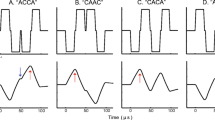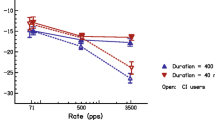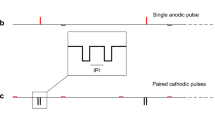Abstract
Stimulation pulse rate affects current amplitude discrimination by cochlear implant (CI) users, indicated by the evidence that the JND (just noticeable difference) in current amplitude delivered by a CI electrode becomes larger at higher pulse rates. However, it is not clearly understood whether pulse rate would affect discrimination of speech intensities presented acoustically to CI processors, or what the size of this effect might be. Intensity discrimination depends on two factors: the growth of loudness with increasing sound intensity and the loudness JND (or the just noticeable loudness increment). This study evaluated the hypothesis that stimulation pulse rate affects loudness JND. This was done by measuring current amplitude JNDs in an experiment design based on signal detection theory according to which loudness discrimination is related to internal noise (which is manifested by variability in loudness percept in response to repetitions of the same physical stimulus). Current amplitude JNDs were measured for equally loud pulse trains of 500 and 3000 pps (pulses per second) by increasing the current amplitude of the target pulse train until it was perceived just louder than a same-rate or different-rate reference pulse train. The JND measures were obtained at two presentation levels. At the louder level, the current amplitude JNDs were affected by the rate of the reference pulse train in a way that was consistent with greater noise or variability in loudness perception for the higher pulse rate. The results suggest that increasing pulse rate from 500 to 3000 pps can increase loudness JND by 60 % at the upper portion of the dynamic range. This is equivalent to a 38 % reduction in the number of discriminable steps for acoustic and speech intensities.



Similar content being viewed by others
References
Allen JB, Neely ST (1997) Modeling the relation between the intensity just-noticeable difference and loudness for pure tones and wideband noise. J Acoust Soc Am 102:3628–3646
Azadpour M, McKay CM (2014) Processing of speech temporal and spectral information by users of auditory brainstem implants and cochlear implants. Ear Hear
Beck JM, Ma WJ, Pitkow X, Latham PE, Pouget A (2012) Not noisy, just wrong: the role of suboptimal inference in behavioral variability. Neuron 74:30–39
Boulet J, White M, Bruce IC (2015) Temporal considerations for stimulating spiral ganglion neurons with cochlear implants. J Assoc Res Otolaryngol
Carlyon RP, Moore BC (1984) Intensity discrimination: a severe departure from Weber’s law. J Acoust Soc Am 76:1369–1376
Carlyon RP, Deeks JM, McKay CM (2010) The upper limit of temporal pitch for cochlear-implant listeners: stimulus duration, conditioner pulses, and the number of electrodes stimulated. J Acoust Soc Am 127:1469–1478
Durlach NI, Braida LD (1969) Intensity perception. I. Preliminary theory of intensity resolution. J Acoust Soc Am 46:372–383
Faisal AA, Selen LP, Wolpert DM (2008) Noise in the nervous system. Nat Rev Neurosci 9:292–303
Fraser M, McKay CM (2012) Temporal modulation transfer functions in cochlear implantees using a method that limits overall loudness cues. Hear Res 283:59–69
Galvin JJ 3rd, Fu QJ (2005) Effects of stimulation rate, mode and level on modulation detection by cochlear implant users. J Assoc Res Otolaryngol 6:269–279
Galvin JJ 3rd, Fu QJ (2009) Influence of stimulation rate and loudness growth on modulation detection and intensity discrimination in cochlear implant users. Hear Res 250:46–54
Green DM, Swets JA (1966) Signal detection theory and psychophysics: John Wiley & Sons, New York
Green T, Faulkner A, Rosen S (2012) Variations in carrier pulse rate and the perception of amplitude modulation in cochlear implant users. Ear Hear 33:221–230
Hu N, Miller CA, Abbas PJ, Robinson BK, Woo J (2010) Changes in auditory nerve responses across the duration of sinusoidally amplitude-modulated electric pulse-train stimuli. J Assoc Res Otolaryngol 11:641–656
Jesteadt W, Nizami L, Schairer KS (2003) A measure of internal noise based on sample discrimination. J Acoust Soc Am 114:2147–2157
Kreft HA, Donaldson GS, Nelson DA (2004a) Effects of pulse rate and electrode array design on intensity discrimination in cochlear implant users. J Acoust Soc Am 116:2258–2268
Kreft HA, Donaldson GS, Nelson DA (2004b) Effects of pulse rate on threshold and dynamic range in Clarion cochlear-implant users. J Acoust Soc Am 115:1885–1888
Levitt H (1971) Transformed up-down methods in psychoacoustics. J Acoust Soc Am 49(Suppl 2):467+
McKay CM, McDermott HJ (1998) Loudness perception with pulsatile electrical stimulation: the effect of interpulse intervals. J Acoust Soc Am 104:1061–1074
McKay CM, Lim HH, Lenarz T (2013) Temporal processing in the auditory system: insights from cochlear and auditory midbrain implantees. J Assoc Res Otolaryngol 14:103–124
Middlebrooks JC (2008) Cochlear-implant high pulse rate and narrow electrode configuration impair transmission of temporal information to the auditory cortex. J Neurophysiol 100:92–107
Miller CA, Hu N, Zhang F, Robinson BK, Abbas PJ (2008) Changes across time in the temporal responses of auditory nerve fibers stimulated by electric pulse trains. J Assoc Res Otolaryngol 9:122–137
Nelson DA, Schmitz JL, Donaldson GS, Viemeister NF, Javel E (1996) Intensity discrimination as a function of stimulus level with electric stimulation. J Acoust Soc Am 100:2393–2414
Oxenham AJ, Buus S (2000) Level discrimination of sinusoids as a function of duration and level for fixed-level, roving-level, and across-frequency conditions. J Acoust Soc Am 107:1605–1614
Pfingst BE, Xu L, Thompson CS (2007) Effects of carrier pulse rate and stimulation site on modulation detection by subjects with cochlear implants. J Acoust Soc Am 121:2236–2246
Plack CJ, Oxenham AJ, Drga V (2002) Linear and nonlinear processes in temporal masking. Acta Acust United Ac 88:348–358
Schroder AC, Viemeister NF, Nelson DA (1994) Intensity discrimination in normal-hearing and hearing-impaired listeners. J Acoust Soc Am 96:2683–2693
Spiegel MF, Green DM (1981) Two procedures for estimating internal noise. J Acoust Soc Am 70:69–73
Wojtczak M, Donaldson GS, Viemeister NF (2003) Intensity discrimination and increment detection in cochlear-implant users. J Acoust Soc Am 114:396–407
Woo J, Miller CA, Abbas PJ (2010) The dependence of auditory nerve rate adaptation on electric stimulus parameters, electrode position, and fiber diameter: a computer model study. J Assoc Res Otolaryngol 11:283–296
Zhang F, Miller CA, Robinson BK, Abbas PJ, Hu N (2007) Changes across time in spike rate and spike amplitude of auditory nerve fibers stimulated by electric pulse trains. J Assoc Res Otolaryngol 8:356–372
Zhou N, Xu L, Pfingst BE (2012) Characteristics of detection thresholds and maximum comfortable loudness levels as a function of pulse rate in human cochlear implant users. Hear Res 284:25–32
Acknowledgements
We thank the CI user participants for their contribution to this research and the Cochlear Corporation for making research tools available. This study was supported by grants from the National Organization for Hearing Research (NOHR) and NIH/NIDCD. The Bionics Institute acknowledges the support it receives from the Victorian Government through its Operational Infrastructure Support Program.
Author information
Authors and Affiliations
Corresponding author
Ethics declarations
Conflict of Interest
The authors declare that they have no conflict of interest.
Appendix
Appendix
The aim of this section is to mathematically demonstrate that the number of acoustic intensity JNDs (or the number of discriminable intensity steps) available to CI users is equal to the number of JND steps along the perceptual dimension of loudness.
Assume that Ψ is the psychophysical transformation between current amplitude A on a CI electrode and the perceived loudness L, and Ф is the function that maps envelope intensity I of the corresponding acoustic channel to current amplitude A. The perceived loudness of the stimulus is:
Assume ΔL, ΔA, and ∆I are the just noticeable differences (JND) in loudness, current amplitude, and acoustic intensity respectively. Using Eq. (1), the relation between ΔL, ΔA, and ∆I can be described by:
After expanding the terms Ψ(A + ΔA) and Ψ(Ф(I + ∆I)), ΔL can be written as:
ΔL can be rewritten as:
The H.O.T (higher order terms) can be ignored if ΔA and ∆I are small and the current-to-loudness and intensity-to-current functions are approximately linear within the small range. Therefore:
Equation (2) shows that ΔL can be described by ΔA and the slope of the current-to-loudness function \( \left(\frac{dL}{dA}\right). \) ΔL can also be described by ∆I and the slope of the intensity-to-loudness function \( \left(\frac{dL}{dI}\right). \) Equation (2) can be rewritten as:
The number of loudness JNDs (or the discriminable loudness steps) across the loudness range L1 and L2 can be mathematically formulated as (Allen and Neely, 1997):
Similarly, the number of current amplitude JNDs (or the discriminable current amplitude steps) within the amplitude range A1 and A2 that corresponds to the loudness range L1 and L2 can be written as:
Similar to above, the number of acoustic intensity JNDs (or the discriminable intensity steps) within the intensity range I1 and I2 that corresponds to the loudness range L1 and L2 can be written as:
Using Eq. (3) it can be demonstrated that:
The number of intensity and current amplitude JNDs is equal to the number of loudness JNDs only. The growth of loudness with current amplitude (Ψ), the acoustic-to-electric mapping (Ф), the absolute values of I1, I2, A1, and A2 and the dynamic ranges I2 − I1 and A2 − A1 are irrelevant to the number of discriminable level steps.
Rights and permissions
About this article
Cite this article
Azadpour, M., McKay, C.M. & Svirsky, M.A. Effect of Pulse Rate on Loudness Discrimination in Cochlear Implant Users. JARO 19, 287–299 (2018). https://doi.org/10.1007/s10162-018-0658-8
Received:
Accepted:
Published:
Issue Date:
DOI: https://doi.org/10.1007/s10162-018-0658-8




